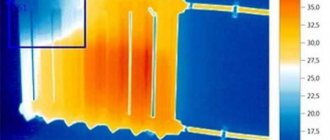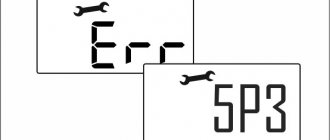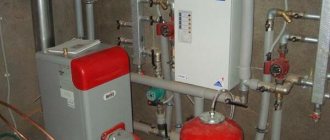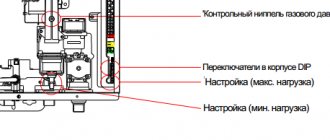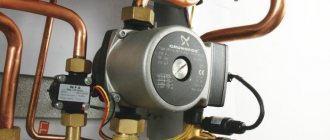If the normal operation of the gas boiler is disrupted, the indicator displays an error message. Knowing the meaning of the displayed error code, the specialist determines in which direction to look for the malfunction.
Good day or night, dear readers. I’m sure that if your gas boiler is “sick,” you won’t leave it alone at night. We swam... we know! So, a thermometer can help you, by looking at the values you can determine “where it hurts”
This thermometer is an indicator on the boiler control panel, and if you know the meaning of the error code that the boiler electronics gives you, this can greatly facilitate the task of troubleshooting.
It will also not be superfluous to know where and what sensor is located.
Because before you start with error codes, you should know that “Boiler Brains” are guided by the readings of various sensors and sometimes a malfunction not of the boiler, but of the sensor itself can lead to an error.
Localizing the problem of boiler malfunction
With the development of modern low-rise construction and gas networks, the boiler has become a common household appliance in every house or apartment. Basically, after installation, the boiler does not cause users any trouble. Modern boilers operate completely autonomously and require only regular maintenance or inspection. In our opinion, the average operating time of units before the first breakdown is from 4 to 6 years. Some users encounter problems even after 9 years, and some, on the contrary, earlier. In this material I will tell you what can be done if the boiler simply does not turn on, and I will also consider the most common malfunctions of gas boilers. The concept of “does not turn on” can mean completely different problems:
- There is no indication (the display is not lit)
- The boiler does not light up
- The boiler does not operate in any particular mode
Therefore, these different situations should be considered separately in detail. Please note that to eliminate some malfunctions, user intervention is sufficient, but in some cases it is necessary to call a qualified specialist.
Code 109
Code 109
The error appears when the system pressure is critically high (more than 3 bar). This is possible in the following cases:
- Excess fluid in the system.
- Airy batteries.
The problem can be solved by forcibly draining some of the water from the heating system, as well as bleeding air from all existing batteries.
Problems starting with the number 2 appear only in those models that have two circuits working for heating and water heating.
The boiler does not turn on - there is no indication
Almost all modern gas boilers are equipped with a control board and an information panel with a liquid crystal display or LED indicators. If there is no indication, first of all you need to make sure that power is supplied to the boiler. Typically, the electrical connection of the boiler is carried out through a separate “automatic machine” - check whether it is turned on or not.
The surest way to make sure that power is supplied to the boiler is to check with a multimeter in voltmeter mode the presence of 220V at the connection point to the boiler board. If there is no voltage, it is necessary to localize and eliminate the problem. In real life, it happens that someone in the household simply pulls the plug from the socket.
Safety fuses
It is also worth paying attention to the location of the fuses. In some boilers, depending on the model (for example, Ariston, Buderus, Vaillant), the fuses are located on the board itself, and in some, before they are connected to the board. If there are no problems with the electrical connection to the boiler, you should check the integrity of the fuses (with the same multitester in the “continuity” mode).
If the fuses are intact and there is 220 volts at the control points, it is likely that the boiler does not turn on due to a malfunction of the control electronics.
If during the inspection it turns out that the fuses have blown, then there was at least a problem with the power supply. In this case, it would be correct to first conduct research on the actuators (fan, pump, priority valve) and boiler wiring for a short circuit. However, in practice, even representatives of specialized organizations simply replace the fuses with good ones and check the boiler in operation. If the fuses blow again, then sequentially turn off the high-voltage parts of the boiler to identify the problem area (this is not a recommendation for action! This approach is not entirely correct).
Several spare fuses are usually supplied with the boiler.
If the fuses blow due to damage to one of the actuators, it must be replaced (or the cause of the short circuit must be eliminated). In the case where it is proven that the mechanisms (and wiring) are in good working order, the control board itself remains. Blown fuses indicate that there was an unacceptable load on the electronics (thunderstorm, pulsed power surge in the network), so the cause of the malfunction may also be a short circuit on the board itself.
Water (moisture) getting on the board
Water ingress is one of the most unpleasant situations. Although the board is in a protective case, water may get inside due to leakage or condensation. Often it gets into the box through the wires. Water ingress almost always causes damage to the board, in most cases irreparable. Characteristic stains and oxidation will be visible on the board due to water.
Varistor and power supply
Often, if the boiler board is damaged, burnt or charred elements can be visually detected on it. A varistor is a protective element of the board that is installed at the input of the circuit. In most cases, this is a blue round part (but not necessarily). When the rated load is exceeded, the varistor is destroyed and opens the circuit. In some cases, if the varistor helped prevent damage to the electronics, biting it out is enough to eliminate the gap in the circuit. Important! Although the board circuit will work without a varistor, it should be remembered that the varistor is a protective device and the correct solution would be to replace it. The power supply is a microcircuit that is also damaged primarily by pulsed power surges or during a thunderstorm. If cracks or damage are visible, the boiler board will likely need to be diagnosed and repaired.
Display board
For some boiler models (Vaillant, Ariston, Navien), the control unit consists of a main board and an information board (display board). The boiler may also not turn on if the display board is broken. The display board, unlike the main one, is cheaper, but most often cannot be repaired. In this case, the fault can only be identified by replacing a known good part.
If the gas boiler is working, there is an indication on the display, but it does not start or produces errors, further diagnostics are required.
Types of errors
Ariston gas boilers are convenient in that all generated errors are grouped directly by node. This simplifies the process of troubleshooting, since one error cannot have several diverse causes in different parts of the boiler. Accordingly, the search for the problem is accelerated and repairs are simplified.
The manufacturer has divided all possible faults into several units:
- Heating circuit - errors in this part of the boiler occur most often and are associated mainly with improper operation of the device or failure of individual parts. Errors start at one.
- Hot water supply circuit - errors begin with a two and appear in double-circuit boilers when there is a malfunction in the supply and heating of water.
- Electronic unit - the first number in errors is 3. These errors are the most difficult to solve and often lead to the need to replace expensive parts, boards and controllers.
- Malfunctions in ignition are marked with the initial number 5.
This division simplifies the repair process as much as possible. There is no point in looking for a problem with error code 301 in a faulty ignition, when such markings make it clear that the fault is in the electronic unit.
This unit in the boiler fails more often than others, especially if preventive cleaning is not carried out. If the display shows a code where the first digit is 1, then the following problems may occur.
The boiler does not light up
If a gas boiler does not ignite, then in most cases there will be an error signal on the information panel indicating its number or code, by which you can approximately find out in which boiler system the malfunction occurred and how critical it is. All double-circuit boilers provide switching between summer and winter operating modes. In summer mode, the boiler will not turn on to heat the room (the same is true when using weather-compensated automation or thermostats).
If the boiler does not ignite and does not make any attempts to turn on (stands idle) when necessary, this may be an electronic malfunction, but such cases are rare and concern specific boiler models.
Usually, if there is a malfunction that prevents the boiler from operating normally, the user will receive an error. That is, if the boiler does not ignite, you need to determine the error code and find its meaning in the equipment operating manual. Error codes with descriptions are always indicated there.
Next, we will consider the most common boiler malfunctions that users encounter. It is worth mentioning here that mostly all modern boilers have the same basic structure and operating procedure. However, to solve a specific problem on a specific boiler, you need to at least read the instructions for that boiler.
Several unsuccessful ignition attempts
This is the very first error code for most equipment manufacturers. For BAXI E01 boilers, for Arison 501 boilers, for Vaillant F28. Ignition of the gas-air mixture in the combustion chamber will occur under two conditions: the presence of gas at the burner nozzles and the presence of a spark. Gas enters the burner through the gas valve, the spark is generated by a transformer on the control board (or remote). A separate case should be noted when ignition occurs, but the boiler cannot detect the presence of a flame and goes out (closes the gas supply valve).
The most common reasons:
Phasing error
. Often, gas boiler boards require connection polarity. For the average user, this means that the position of the plug in the outlet matters. If the connection polarity is reversed, the boiler does not see the presence of a flame, continues ignition (electrode crackling) even when there is already a flame on the burner, then turns off due to an emergency. Even if you did not touch the plug, the polarity could change at the substation!
Ignition or flame ionization electrode
. It can be separate or combined. The main problems may be related to contamination (oxidation) of the electrode or its gap relative to the burner. A dirty ionization electrode prevents the board from detecting the presence of a flame and operation stops.
High voltage wire. High voltage is generated by a transformer and transmitted through a wire to the electrode, where it pierces the air gap between the burner and the electrode with a spark. If a characteristic crackling sound is heard, but a spark on the burner is not visually visible, it is possible that the breakdown is occurring somewhere else. For example, there is a microcrack in the insulation of a high-voltage wire, and a breakdown occurs at the point where the insulation on the housing is broken.
Electrical connection problems
. The presence of parasitic potentials on the boiler body, lack of grounding or low voltage of the supply network can cause problems with ignition. I often hear the argument: everything used to work without grounding. No one will understand how the boiler worked without grounding. According to the operating instructions, this must be done! For normal operation of the boiler there must be: a network voltage of at least 180 volts, a potential between the neutral and ground wires of up to 10 volts, and the presence of grounding.
No gas on the burner
. The gas valve controls the gas supply to the burner: it opens and modulates (gas dosing). The gas valves are regulated and controlled by a control board. Accordingly, the cause of the problems may be a malfunction of the valve (or the need for adjustment), its electrical part, or the control circuit on the board. This device should be checked by a specialist. The lack of gas can also be due to external factors: a faulty meter, dirty filters.
Control board.
In some cases, lack of ignition or flame control is caused by a malfunction of the boiler main board. This can be considered after the other possible causes as described above have been accurately checked.
Insufficient draft (fan does not turn on)
Also a popular problem. If there is a problem with the removal of combustion products, the boiler will not start and ignite until it is completely eliminated. Such malfunctions and their solutions are described in more detail in a separate article - chimney errors.
Insufficient water pressure (refill required)
Traditional gas boilers operate in a closed heating system; accordingly, to prevent the boiler from turning into a hydrogen bomb, there must be a minimum water pressure inside the heat exchanger (in fact, the presence of water and circulation there). The pressure is controlled by a special sensor - a pressure sensor. The boilers are provided with an additional mechanical pressure gauge for the user. Although the systems are closed, the pressure in them can drop over time (for example, water escapes through leaks in the connections). As soon as the water pressure in the boiler drops below the minimum level (0.5 - 0.7 bar), the boiler sensor detects a malfunction and blocks operation. In most cases, you just need to study the readings of the mechanical pressure gauge and recharge the system according to the instructions for the boiler.
Code 101
Code 101
The error occurs when the coolant overheats, which prompts the automation to completely block the operation of the boiler until the temperature readings return to normal.
The reasons may be:
- The coarse filter is dirty.
- Scale on the heat exchanger, lack of preventive cleaning.
- A malfunction of the pump that circulates water through the system.
- Damage and malfunction of the NTC sensor.
- Malfunction of the electronic control board, which generates a false high temperature signal.
Often with error 101 you can notice an increase in pressure at the outlet of the gas valve. Repair and search for the cause is possible only by experienced specialists. The maximum that can be done at home is to check how well the pump is functioning.
Code 102
The boiler does not work in DHW or heating mode
And finally, situations when the boiler does not operate in a particular mode. They happen much less frequently compared to others. In this case, it is likely that the boiler will need to be diagnosed by a specialist. The process of ignition and operation of the boiler in different modes is virtually the same, with the exception that different modes may have different power. In hot water preparation mode, the boiler power is usually full, but in heating mode it can be minimal. You can read about problems in the operation of the DHW mode in a separate article.
Code 108
It is characterized by a sharp decrease in pressure in the heating system, which is recorded on the pressure gauge. In this case, the boiler operation stops.
There are several reasons:
- Lack of water in the expansion tank - the liquid has evaporated and the person did not notice.
- The water left through the supply system - the person forgot to close the water supply tap, and when the water supply was turned off, the water left the heating system automatically.
- Water leakage directly in the heating system - pipes are leaking at soldering or twisting points.
What can be done in such a situation?
- First, check the water level in the expansion tank, add if it is below normal. Do the same procedure if your water intake into the heating system is from a central water supply, then close the tap tightly.
- Secondly, check if your pipes and radiators are leaking. If there is a leak, it must be repaired.
Summary
In this article we looked at the most common cases when the boiler does not turn on or ignite. No one anywhere on the Internet will definitely tell you why your boiler won’t turn on; this requires at least an external inspection. This material will help you get acquainted with possible situations in general and is written on the basis of our statistics over several years.
If there is a malfunction, you need to determine the error and read the boiler operating manual. Also, for many boiler models, error descriptions with recommendations are available on our website. Malfunctions can be simple, which the user can fix independently, or complex, requiring qualified assistance and spare parts. We strongly do not recommend performing any actions with the boiler if you do not fully understand its structure and principles of operation, disabling protective devices or changing the boiler’s operation circuit to restore its operation. If there is a malfunction, it must be eliminated! If the cause of the malfunction is not completely clear to you, it is better to call a specialist.
Code 103
The error is due to the coolant heating too quickly, which can be caused by the following reasons:
- airiness of batteries;
- thermostat malfunction;
- problems with the board.
If such an error occurs, you can try to bleed air from all existing batteries. In most cases, this will fix the problem. If after such actions the code continues to be displayed on the display, then the problem is deeper and cannot be done without the help of specialists.
Purpose of sensors and where they are located
We look at the pictures, read the inscriptions - here we have collected all the sensors used in the boiler and reporting any error. With the exception of the pressure sensor, it is not included in this diagram, since it is not used in this boiler model. Well, a sensor with a pressure gauge is not yet indicated, I think everything is clear there, it’s just an indicator reporting the amount of pressure in the circuit. By the way, in some modifications of boilers, the submersible temperature sensor in the DHW circuit - NTCs - may also not be installed.
Checking the gas supply
The presence of gas supply to the Ariston boiler is immediately checked. To do this, in a house or apartment, go to the gas stove and check whether the gas lights up on it or not. If there is a gas supply, it will be necessary to “restart” the boiler. To do this, press the “Reset” button in the boiler control menu. After the reboot, if the problem does not disappear, then carry out the diagnostic procedure. If you are not confident in your abilities, then diagnostic and repair procedures should be entrusted to a professional specialist who will do everything correctly.
Removing air pockets in the system
It's better to start with batteries. To remove air pockets, a Mayevsky tap is usually installed on them. We open it and wait for the water to run. Did you run? Let's close. Such manipulations must be done with each heating device separately.
How to start a boiler with your own hands photo
After the air is removed from the batteries, the pressure in the system will decrease and the pressure gauge needle will drop. At this stage of work, the solution to the question of how to start the boiler involves re-filling the system with liquid.
Now, the most difficult thing is that starting gas boilers requires bleeding air from the circulation pump. To do this, the boiler needs to be disassembled a little. We remove the front cover and look for a cylindrical object with a shiny lid in the middle, which has a slot for a screwdriver. After we have found it, we put the boiler into operation - we supply it with electrical power and set the water heating controls to the operating position.
Relieving air from the circulation pump when starting the boiler photo
The circulation pump will immediately turn on - you will hear a faint hum and loud gurgling and many incomprehensible sounds. This is fine. As long as the pump is aired, it will be so. Take a screwdriver and slowly unscrew the cap in the middle of the pump - as soon as water starts seeping out from under it, screw it back. After two or three such manipulations, the air will come out completely, the strange sounds will subside, the electric ignition will work and start working. Check the pressure again and add water to the system if necessary.
Basically, that's it. While the system is warming up, you can begin to study the instructions in detail (if, of course, you have not already done so) and start debugging the system that involves starting the boiler. Everything is simple here - the batteries closest to the boiler need to be screwed on, and the ones farther away need to be turned on to their full potential. This debugging is carried out using control valves installed on the supply connection pipe to the heating radiator.
